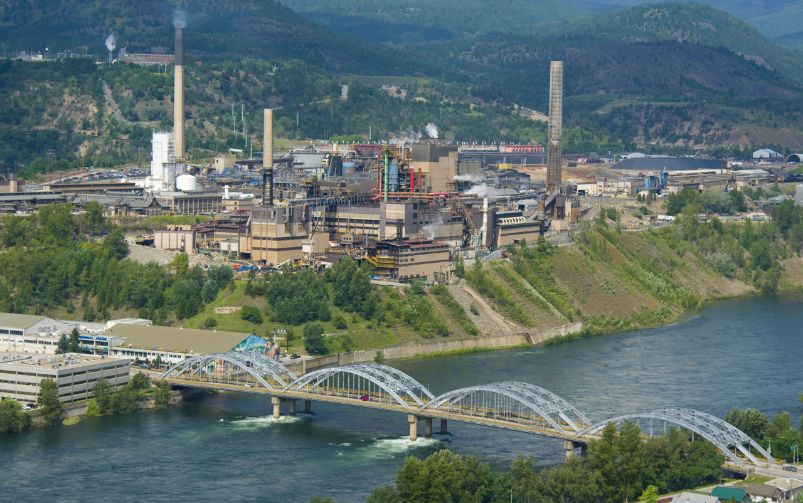Serpentinite is a common form of ultramafic rock that is rich in serpentine minerals and can naturally mineralize atmospheric CO2. Photo: Dave Zeko
Natural Resources Canada (NRCan) announced on Nov. 28, 2024, that it will grant over $1.8 million in funding to Vancouver-headquartered Arca Climate Technologies Inc. to further develop its technology that uses microwave radiation to enhance the carbon capture capacity of minerals in ultramafic tailings.
The funding was part of $12.5 million awarded to six projects in British Columbia that aim to develop clean technologies that could mitigate carbon emissions from industrial activities.
Arca discovered that applying microwave radiation to tailings accelerates, or “activates,” carbon mineralization, a natural geochemical process that occurs when certain rocks or minerals are weathered and exposed to the air, where they combine with CO2 in the atmosphere to form stable carbonate minerals. This chemical reaction is particularly strong in ultramafic rock as it is rich in magnesium and iron, which makes it highly reactive to CO2.
Nickel deposits are commonly found in ultramafic rock, especially in Canada and Australia, and the enormous amounts of tailings from nickel mines already naturally capture and store CO2.
For its microwave-based mineral activation technology, Arca focuses on a specific group of minerals in the tailings, called serpentine minerals, to accelerate the carbon mineralization process.
“The most interesting category of minerals [in the tailings] is serpentine; these are hydrous silicate minerals that contain a lot of magnesium,” said Needham. “But given the structure of the mineral, the molecular bonds are strong. The magnesium does not readily leach or react with CO2 and yet it’s highly abundant. The mine waste might be 80 per cent serpentine, so there’s a lot of potential there [for carbon capture and storage].”
“Microwaves heat from the inside out, and the water component of the serpentine mineral absorbs the microwave energy first, then dehydroxylates—which is sort of like dehydration,” Needham added. “As a result, the water component is released from the serpentine mineral, which in turn breaks the chemical bonds with the magnesium, and therefore we’re liberating the magnesium by using this microwave energy.”
The federal funding from NRCan will allow Arca to scale up its mineral activation technology and go from processing kilograms of tailings on a batch basis once a month at its site in Vancouver, to processing tonnes of tailings continuously throughout the month.
“To date, what we have is a large prototype where we can process kilograms of material at a time,” said Needham. “What this funding is allowing us to do is to develop a flow-through reactor.”
Scaling up its prototype will also allow Arca to better test its technology. “[We’ll] have much better data about the effectiveness of this technology and the appropriateness of this technology for different mine sites,” he said.
According to Needham, the funding will help Arca bring its prototype from a technology-readiness level four to a level six.
“That takes us closer to a design that would be deployable,” said Needham. “Technology-readiness level six for us would be the scale and functionality that we could potentially take it to a mine site and do a pilot. So, all of the coarse subcomponents are integrated into a system. Each of the components may be operating at too small of a scale, but [would allow] us to test an integrated system.”
Still, working with microwaves—and getting them to apply evenly to the tailings—is tricky, according to Needham.
“In a batch scale is one thing, [but] doing that in a continuous flow while the material is moving along is another,” said Needham. “You’re also now handling very hot material and in larger volume. It’s about heating rocks to over 650 degrees Celsius and doing it very fast. One of the challenges we had was simply getting enough clean power to our facility. We had to upgrade our power from BC Hydro to ensure we’re getting enough power to run the experiments.”
Although Arca’s mineral activation technology is well suited for nickel mines, the company is also looking to deploy its technology in tailings from chromite, diamond and asbestos mines, as these deposits are also found in ultramafic rock and are rich in serpentine.
“There’s a lot of legacy asbestos mine waste, so we are looking at some really interesting opportunities there too,” said Needham. “This mineral activation technology that we’re talking about—the microwave-based technology—not only captures more CO2, [but] it also destroys the asbestos. So, [there is] opportunity here for site remediation.”
Arca’s mineral activation technology works independently from its smart churning technology, which uses rovers to move over the surface of tailings, churn up the surface and expose the minerals to air. Since December 2023, Arca has been piloting its smart churning technology to capture carbon at BHP’s Nickel West mine at Mount Keith in Kalgoorlie, Western Australia.
While they are separate technologies, according to Needham, they can support each other. “After we microwave the material and activate the minerals, then the material would be out on the tailings storage facility,” he explained. “Then we would start churning it as well to further increase [the] rate of capture.”
Needham believes that Canada has the opportunity to be a world leader in carbon dioxide removal and an exporter of carbon capture and storage technologies.
“Canada, and British Columbia in particular, have an enormous potential and a very large supply of serpentine,” he said. “Within the top kilometre of [the bedrock in] British Columbia, there’s enough serpentine to capture hundreds of billions of tonnes of CO2 from the atmosphere. The scale of the opportunity is massive.”




